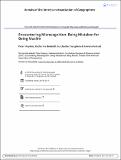Files in this item
Encountering misrecognition : being mistaken for being Muslim
Item metadata
| dc.contributor.author | Hopkins, Peter | |
| dc.contributor.author | Botterill, Katherine | |
| dc.contributor.author | Sanghera, Gurchathen | |
| dc.contributor.author | Arshad, Rowena | |
| dc.date.accessioned | 2017-03-01T15:30:10Z | |
| dc.date.available | 2017-03-01T15:30:10Z | |
| dc.date.issued | 2017 | |
| dc.identifier | 249017076 | |
| dc.identifier | b4acf4d8-f8c4-41ef-ae8d-9cc363dc6b23 | |
| dc.identifier | 85014564930 | |
| dc.identifier | 000402684200010 | |
| dc.identifier.citation | Hopkins , P , Botterill , K , Sanghera , G & Arshad , R 2017 , ' Encountering misrecognition : being mistaken for being Muslim ' , Annals of the American Association of Geographers , vol. 107 , no. 4 , pp. 934-948 . https://doi.org/10.1080/24694452.2016.1270192 | en |
| dc.identifier.issn | 2469-4452 | |
| dc.identifier.other | ORCID: /0000-0003-1075-3412/work/76777199 | |
| dc.identifier.uri | https://hdl.handle.net/10023/10386 | |
| dc.description | This research was supported by the Arts and Humanities Research Council (reference number AH/K000594/1). | en |
| dc.description.abstract | Exploring both debates about misrecognition and explorations of encounters, this paper focuses upon the experiences of ethnic and religious minority young people who are mistaken for being Muslim in Scotland. We explore experiences of encountering misrecognition, including young people’s understandings of, and responses to, such encounters. Recognising how racism and religious discrimination operate to marginalise people – and how people manage and respond to this – is crucial in the struggle for social justice. Our focus is upon young people from a diversity of ethnic and religious minority groups who are growing up in urban, suburban and rural Scotland, 382 of whom participated in 45 focus groups and 224 interviews. We found that young Sikhs, Hindus and other South Asian young people as well as Black and Caribbean young people were regularly mistaken for being Muslim. These encounters tended to take place at school, in taxis, at the airport and in public spaces. Our analysis points to a dynamic set of interconnected issues shaping young people’s experiences of misrecognition across a range of mediatised, geopoliticised and educational spaces. Geopolitical events and their representation in the media, the homogenisation of the South ‘Asian’ community and the lack of visibility offered to non-Muslim ethnic and religious minority groups all worked to construct our participants as ‘Muslims’. Young people demonstrated agency and creativity in handling and responding to these encounters including: using humour; clarifying their religious affiliation; social withdrawal and ignoring the situation. Redressing misrecognition requires institutional change in order to ensure parity of participation in society. | |
| dc.format.extent | 534653 | |
| dc.language.iso | eng | |
| dc.relation.ispartof | Annals of the American Association of Geographers | en |
| dc.subject | Race | en |
| dc.subject | Islamophobia | en |
| dc.subject | Encounters | en |
| dc.subject | Geopolitics | en |
| dc.subject | Identity | en |
| dc.subject | H Social Sciences | en |
| dc.subject | GF Human ecology. Anthropogeography | en |
| dc.subject | JZ International relations | en |
| dc.subject | NDAS | en |
| dc.subject.lcc | H | en |
| dc.subject.lcc | GF | en |
| dc.subject.lcc | JZ | en |
| dc.title | Encountering misrecognition : being mistaken for being Muslim | en |
| dc.type | Journal article | en |
| dc.contributor.sponsor | Arts and Humanities Research Council | en |
| dc.contributor.institution | University of St Andrews. School of International Relations | en |
| dc.contributor.institution | University of St Andrews. Centre for Minorities Research (CMR) | en |
| dc.identifier.doi | 10.1080/24694452.2016.1270192 | |
| dc.description.status | Peer reviewed | en |
| dc.date.embargoedUntil | 2017-02-28 | |
| dc.identifier.url | http://www.tandfonline.com/doi/full/10.1080/24694452.2016.1270192 | en |
| dc.identifier.grantnumber | en |
This item appears in the following Collection(s)
Items in the St Andrews Research Repository are protected by copyright, with all rights reserved, unless otherwise indicated.

